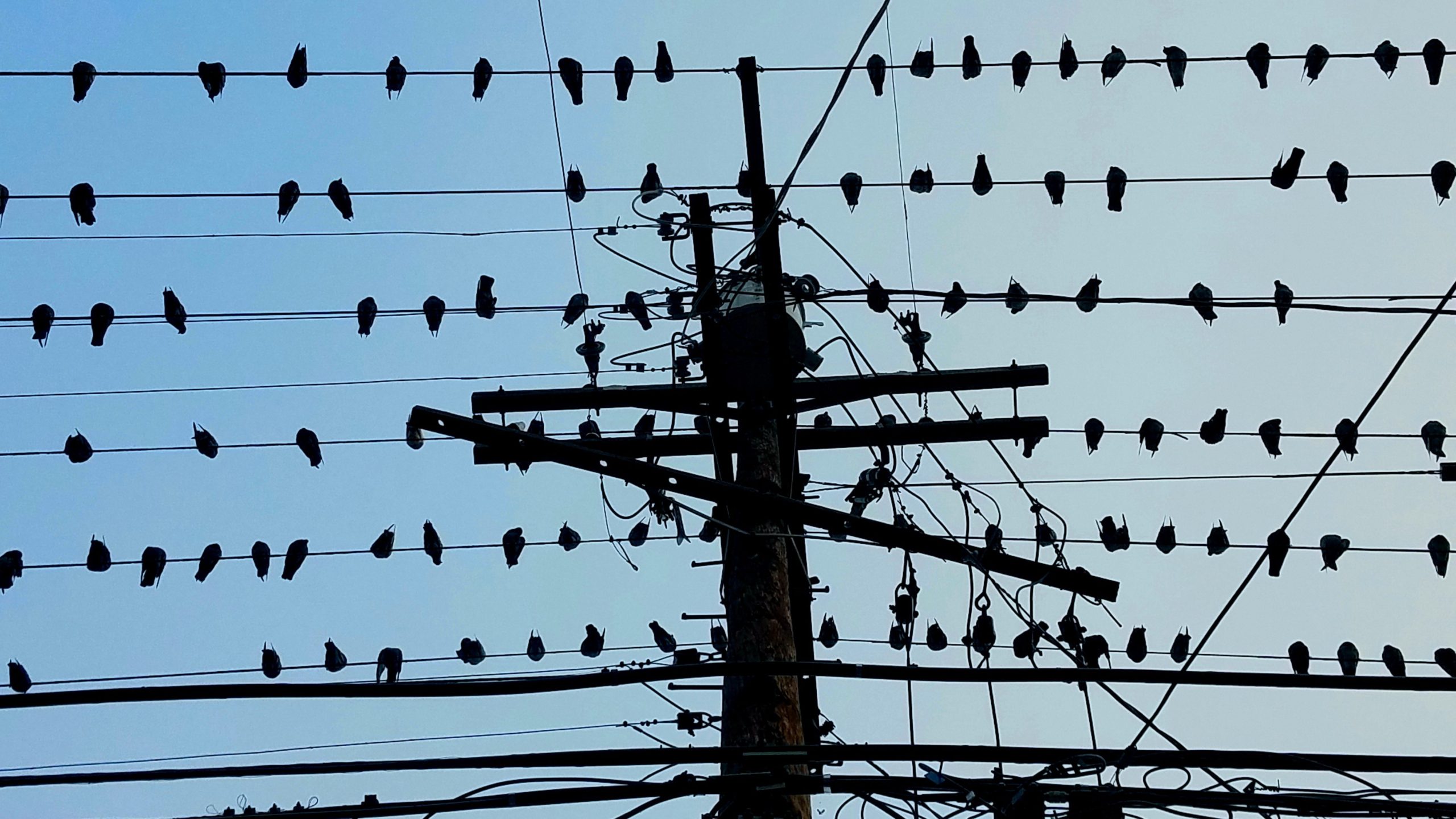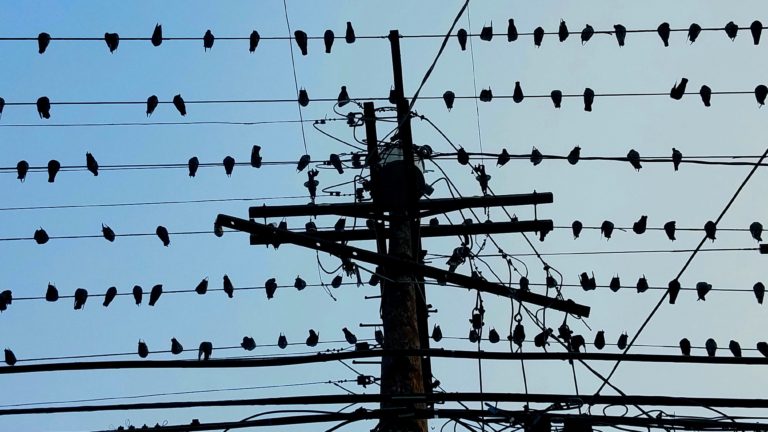Mary Lynn-Giannakou – Fiction
The Canada geese, emboldened by their sheer numbers, increased their territorialism. Competing with the local raccoons, they looted and toppled...

Canada Geese
At first, the park-goers welcomed them, fed them, even. The Canada geese were a pleasant diversion from the local wildlife that made up the ecosystem of Stony Lake Park—a harmonious, if bland, community of deer, chipmunks, hedgehogs, rabbits, and pesky pigeons. In addition to the sheer novelty of the Canada geese, one effect of their arrival was the disappearance of the pigeons. This was deemed a blessing by the cyclists, who’d become accustomed to maneuvering around large groups of pigeons that congregated in their path near benches of well-meaning senior citizens whose sole pastime seemed to be feeding stale breadcrumbs to the park’s winged free-loaders. The old people, of course, missed the fat, slow-moving pigeons who had been their main source of entertainment for years, but once it became clear that the Canada geese would gladly eat the stale breadcrumbs the elders fed them, the pigeons were all but forgotten.
Soon, the geese made Stony Lake their permanent residence. Instead of merely flying over it on their migratory path to and from Canada, they stayed and nested and reproduced. By the end of their second year at the park, the goose population had tripled. Tourists, children, and seniors continued to feed them, and the behavior of the newly-arrived geese gradually changed: They began to venture outward from the lake’s perimeter, honking noisily as they patrolled the grassy fields, harassing picnickers for scraps of food, leaving trails of slimy green and white droppings everywhere they went.
Furthermore, the geese refused to move out of the cyclists’ way, and instead, stubbornly sat in the middle of the path, obstructing them by forming blockades with their large bodies. The cyclists, for their part, began to long for the pigeons, most of whom would scatter at the last minute to avoid being run over. Not so with the Canada geese, who rarely displayed fear of being hit. Once, a frustrated cyclist tried to accelerate and run down a resting goose and its mates, but the goose rose, colliding with the bike, causing the cyclist to flip over his handlebars and land on the asphalt with a thud. He landed near a new mother goose, who attacked and beat him with her substantial wings, hissing, tearing at his hair and clothes with her beak. Another cyclist stopped and used her pepper spray to rescue the man, who was subsequently rushed to the ER, bloody and dazed with a concussion.
Soon after, another goose, feeling its nest threatened by an unsupervised toddler who was balancing on the rocks that lined the lake’s perimeter, used its wings to swat the tot into the water, which by now, was polluted with green goose droppings. Acting quickly, the child’s father yanked her out of the lake, but not before she had inhaled a substantial amount of the polluted water through her nose. She was treated with intra-venous antibiotics at the local hospital for a week before she was discharged in good condition.
The Canada geese, emboldened by their sheer numbers, increased their territorialism. Competing with the local raccoons, they looted and toppled trash cans in the park and surrounding neighborhood. Families whose property abutted the park began to complain of the strewn garbage, the noise and the droppings. The town consulted ecologists, an elderly pair of retired professors who recommended park rangers post signs that warned against feeding the geese and explained it affected their natural behavior and led to contamination of the grasses and lake with droppings.
Still, people persisted in feeding the geese. Tourists, mostly from the nearby city, came to the park on weekends and, ignoring the signs, fed the geese everything from beef jerky to cheese doodles to Fanta. Other more adventurous park visitors helped themselves to baby goslings, birds they intended to keep as pets. But as the goslings grew in size and demands, many people released or abandoned them in the park’s confines. No longer intuitive enough to survive on their own in the wild, these abandoned young geese formed groups that roamed the park and ate trash. Soon, their offspring became the feral Canada geese who regularly challenged the park’s existing Canada goose population, aggressively competing with them for park-goers’ food. The feral geese, having been raised in their owners’ homes during their formative months, had completely lost the ability to fly. That, and their animosity toward the other geese, were their only distinguishing characteristics.
Soon, sections of the park became over-run with Canada geese to the point where regular park-goers—the cyclists, the elderly, parents with young children, runners, and picnickers—avoided these areas entirely. The town called in more experts. The local public television station even aired a documentary called “The Lost Geese of Stony Lake,” which received some of the season’s highest ratings.
Working in conjunction with the city zoo and wildlife experts, park rangers started a program to capture the geese. Some were shipped off to zoos and sanctuaries around the country. Others, deemed too diseased or dangerous, were euthanized. This, in turn, raised the ire of animal rights activists, and daily protests took place, with the activists noisily blocking access to parking lots and putting themselves bodily in front of the targeted geese. When a feral goose attacked a teen activist and ripped most of her left ear off, the protests began to wane.
In the fourth year of what the people of Stony Lake now referred to as “The Occupation,” an avian flu, H5N8, began to circulate among the park’s geese. Zoologists tagged and tracked all diseased geese. The locals, afraid the virus could be transmitted from the birds to humans, avoided the park that fall, even though the infectious disease experts at the Centers for Disease Control declared the virus to be non-transmissible to the human population. For a while that winter, with the park nearly abandoned by humans, it looked like the geese might starve or be overcome by H5N8, which proved fatal for almost one-eighth of the park’s geese. However, by spring, the new goslings were everywhere, and the geese, both tagged and untagged, appeared to be flourishing.
It was then that s small group of local men decided to take matters into their own hands. They organized and, with the cooperation of a few park rangers, decided to unofficially hunt the birds when the park closed at dusk. The hunters began to roam the park freely, arrows and shotguns in tow, and cart away goose carcasses at nightfall. This went on once a week for three months. It would have lasted even longer if, during a hunting foray, a drunken teen, over-confident in his marksmanship, hadn’t accidentally shot his father in the thigh, shattering both his femur and his confidence in his own parenting skills.
Late night television hosts, whose writers caught the story of the father and son on their news feeds, repeated it in their monologues, characterizing the population of Stony Lake as a bunch of dim-witted backwater yokels who deserved the plague of geese. A letter-writing campaign to the big-city newspapers, undertaken by Stony Lake High School’s honors English class, whose Ivy-league educated teacher chafed at being so publicly characterized as a hillbilly on national TV, proved futile. No letters to the editor were printed, and the news story of the boy who had mistakenly shot his father while illegally poaching Canada geese soon faded away.
After ten years of study, the resident zoologists began to notice that the non-migratory Canada geese of Stony Lake Park had a longer life span than migrating Canada geese in the wild. Scientists were baffled as to how the park’s geese managed to outlive their wild counterparts while subsisting on a diet of junk food, garbage, insects, and grasses that were treated with toxic herbicides (once a staple of the geese’s diet, the fish had long since died off from the lake’s polluted, stagnant water). Researchers soon discovered that a large percentage of the Stony Lake geese had become carnivorous, eating chipmunks, field mice, and baby rabbits. Animal experts from around the world visited Stony Lake to observe the park’s newly carnivorous Canada geese. A French film maker petitioned for a permit to make a movie using footage of the geese ravaging the chipmunk population, but was denied. Remembering the animal rights protests from years prior, along with the mocking jokes of the big-city comedians, the town board didn’t want any more publicity or ridicule.
The park changed considerably in the next few years. At one time, people had gone there for a breath of fresh air and a peaceful walk or bike ride around the lake. Now, the putrid stink of the polluted lake and goose droppings repelled even the most avid nature lovers, and the constant high-pitched honking of the geese, along with their hissing and intrusive behavior, ensured that there was no peace to be found in any corner of the park. When weekend visits from city folk drastically decreased, nearby mom-and-pop delis, diners, ice cream stands, and gas stations, which depended on the weekend park traffic that the city visitors generated, closed down. Without the summer jobs these businesses offered, idle teens began to cause trouble, vandalizing the high school and drinking in abandoned parking lots. With boarded up shops and ample graffiti, the village of Stony Lake took on the feel of a ghost town, with the only outside visitors being the few researchers who were still tracking the birds and studying their behavior.
Still, the locals hadn’t given up the fight to take back their park, which was now only open to the public from nine to noon, Monday through Thursday. Reluctantly, since most of its members still believed in local solutions to local problems, the town board called in the U.S. Department of Agriculture’s Wildlife Services. The experts determined that at a significant cost to the municipality of Stony Lake Village, the feds would destroy existing nests and remove fertilized eggs in order to control the ever-growing, ever-menacing Canada goose population.
It wasn’t long before Wildlife Services personnel charged with the job of combatting the Canada geese began to exhibit a strange array of symptoms: high fevers, muscle weakness, trouble swallowing, severe intestinal cramps, and respiratory distress. When four Wildlife Services employees were hospitalized, along with a local park ranger who had driven them around the lake and shown them the nesting sites, the National Institute of Health and the CDC began an investigation. They found that H5N8 had returned and was, in fact, being transmitted from the geese to the humans who set out to destroy them. When they discovered that the virus spread to humans through goose droppings, the project was abandoned and the village put under strict quarantine. One federal worker and the park ranger who had assisted him died of avian flu-related complications. The locked-down townspeople, whose property values were steadily declining, felt desperate and abandoned.
The problem came to a head one August day. To great fanfare, the local Little League team had made it to the nationals, which were to be held in North Carolina. The town suddenly had something to feel good about, and the locals’ morale was high. Sponsored by two of the town’s surviving businesses, the local pizza parlor and credit union, the team took off a day before the nationals in the small chartered plane that was to transport them to North Carolina. But just one mile away from the runway, the plane struck a v-shaped formation of wild Canada geese and crashed, killing fifteen team members, two coaches, three parent chaperones, and two crew members. Though the birds responsible for the tragedy were not even remotely related to the park’s problem geese, the incident brought the issue to the nation’s front pages and talk shows, and suddenly, the village of Stony Lake received an outpouring of sympathy, good wishes, prayers, donations, and, perhaps most importantly, the solution to their most pressing problem.
***
Gunther Talbot was, by all accounts, a wild man. A Texas native and survivalist, Gunther had chosen, ever since being honorably discharged from his Green Beret unit, to live life as an ascetic. He built a small, rustic cabin in the woods on the rural five-hundred-acre tract of Colorado land he had purchased with his savings and military pension. He subsisted on fish he caught in the babbling creek that ran through his property, deer meat that he cured for the winter, the occasional wild turkey, and berries, herbs, and mushrooms that he foraged. Since he was almost completely off the grid, he only heard about the travails of Stony Lake Village while making one of his bi-annual trips into town to buy salt, ammunition, and other vital supplies. The bells tinkled as he pushed open the ancient door of his local hardware store, Dean’s.
A white-bearded man in a baseball hat and plaid flannel shirt greeted him from behind the counter. “Hello there, Gunther. How’s things going in your neck of the woods?”
Gunther, a man of few words whose baritone was creaky from lack of use responded, “I’m in pretty good shape for the shape I’m in. And you?”
“Well, could be better…” and Dean launched into a description of all his current health issues, from hypertension to lumbago to persistent toenail fungus. Gunther shopped while Dean went into minute detail. As he browsed, Gunther nodded his head and gave an affirmative, “Uh-huh” from time to time so as not to seem rude or give the impression that he wasn’t listening.
When Dean finished with his monologue, he slapped his palm down on the folded-over newspaper in front of him. “Say, did you ever hear of a place out east called Stony Lake?”
Gunther stopped. Of course he had. During his West Point cadet days, he and his girlfriend-of-the-month used to hike and picnic and, well, do some other natural activities at that lake. Just hearing its name stirred up warm, fuzzy memories. “Yes,” Gunther said. “I spent some time there when I was younger.”
“Well then,” Dean said, offering him the newspaper, opened to its feature story, “you might want to read this.” Knowing that Gunther was a man of learning, Dean thought it best if he read the information firsthand instead of hearing it from Dean himself, who—unless he was talking about his own health—often muddled facts and figures and left out entire parts of the stories he tried to relate.
“Thanks,” Gunther said, taking the paper in his weathered hand. He started to read the article about Stony Lake and its residents’ struggle with the Canada geese right there at the counter, and the gravity of these good people’s situation moved him deeply. Their losses, described in full detail, especially the tragedy of the plane crash (Gunther had played Little League as a kid and couldn’t fathom how the players’ parents were able to deal with that awful blow), seemed so random and, therefore, so utterly unfair, that he felt he must do something to try to help them.
When he finished reading, he gently placed the paper on the counter and looked at Dean. “Would you mind if I used your phone?”
***
He had rounded up five coyotes from his property, animals that would most likely have ended up at the business end of a rancher’s rifle had he not taken them. The coordination was uncomplicated: Gunther would drive cross-country with the coyotes, meet a rep from the Department of Parks and Recreation (another former Green Beret, it turned out, who used to be involved in Black Ops in El Salvador, an assignment Gunther would have refused if offered during his active service) who would brief him on logistics. Then, working with Stony Lake’s Town Supervisor, he would, without fanfare or publicity, let the coyotes loose in the park. Gunther calculated that the introduction of the predators would sufficiently decrease the Canada goose population so that the park could re-open, possibly even in time for Memorial Day.
The fact that what he was doing was illegal occurred to him, but it certainly didn’t deter him. To his thinking, illegal often just meant that something didn’t make good optics, didn’t garner instant approval in polls, or didn’t automatically make the actors look like the good guys. In his former life as a Green Beret, his practical experience showed him that the term illegal was most often used to label the most politically inconvenient, yet most expedient, way to solve a local problem. The CIA had always understood this, and so had Gunther and his Green Beret unit. In fact, he’d understood it so well that he had made quite a distinguished career of being an expert in flouting international, federal, state, and local laws for what he always believed to be the greater good—which made him the perfect man for the job at hand.
***
When he pulled up to Stony Lake’s barricaded entrance after his unofficial meeting with the Parks and Rec rep, he was surprised to see that the town supervisor, Terry Gordon, whom he’d never spoken to directly on the phone, was a woman. She was wearing what appeared to be a safari suit—beige canvas vest and matching cargo pants with roomy pockets and lots of drawstrings. She wore expensive hiking boots and mirrored aviator sunglasses and had the sinewy, desiccated look of a long-distance runner. She extended a tanned hand and gave Gunther a firm, almost manly handshake.
“Terry Gordon,” she said. “Great to meet you.”
“You, too,” Gunther said, holding onto her hand a beat too long. Terry pushed her sunglasses up on top of her head and regarded him, meeting his gaze with a bold gaze of her own. He could sense she was unflappable, but now that he could see her eyes, he noticed she was also younger than he first thought, no more than thirty-five or thirty-six. There was an awkward silence between then, and then, grinning and stroking his ample auburn beard, he said, “So? Shall we get this party started?”
“Yup,” she said. “But I’d like to see them first. The coyotes, that is.” He shrugged, then opened the livestock trailer. To his surprise, she went in and approached the animals.
“I’d be careful there, if I were you,” he said.
“I’m a vet,” she replied, smiling. He crinkled his forehead, trying to visualize what branch of the military she had served, before settling on the Marines. “A veterinarian,” she clarified, sensing his confusion. He watched as she checked the animals without fear, businesslike. When she found their condition satisfactory, she hopped down from the trailer, wiping her hands on her thigh pockets. “They’re not tagged.”
“Well, my understanding was that where they came from is supposed to be our little secret. Unless you want to….”
“No,” she said, cutting him off emphatically. “There’s no way I want this to be public. I want it to appear as if they just showed up. Like this was something natural….” her voice trailed off. She was conflicted, he realized. Time was of the essence in these situations.
“Don’t worry,” he said. “There’s nothing more natural than a predator showing up where there’s easy prey.” He opened the passenger door for her, and, with a nod, she climbed in. Soon, they were driving around the barricade and heading for the lake.
***
That spring, the two females had litters of six and eight pups each, bringing the total coyote population of Stony Lake Park to nineteen. The Canada geese were easy prey, and the pups grew fast and strong by being fed their parents’ regurgitated remains of the bothersome birds. At first, the locals who heard the coyotes’ yips and howls at night were scared. But when the first Canada goose carcasses were discovered by park rangers, the town was cautiously optimistic. Maybe nature had solved its own problem, they thought. The Canada geese, especially the ones that had forgotten how to fly, could not co-exist with the new predators.
The town supervisor was re-elected, and within a year, the goose population was slashed by almost half. In two years, there were even fewer geese, and cyclists ventured into the park again. The lake, once stagnant and rank with goose droppings, began to repair itself. Slowly, people began to return to the park. The coyotes hunted at night and only appeared around dusk, at closing time. There were a few coyote sightings, mostly by hikers who ventured up the neighboring mountain, but for the most part, the coyotes kept to themselves.
Slowly, the elderly returned to the park, and they mostly left their breadcrumbs at home (the town had installed chess tables, which kept them busy and lessened the temptation to feed the wildlife). The senior citizens were followed by the pigeons, who, on a more restricted diet, were less of a nuisance to cyclists. Gradually, new businesses opened: an art gallery, a yoga studio, a cupcake bakery, a tapas place, a wine store, and an organic market. The village of Stony Lake was re-branding itself. It became a mecca for young city families on the weekends, and some of them bought houses there, undeterred by the longer commute. Many of the new residents had dogs, and upon taking her leave from local politics, Terry Gordon returned to her original passion and opened her own veterinary practice.
And Gunther Talbot? Rumor has it that before he clandestinely returned to his sprawling five-hundred acres in Colorado, he left behind a gift besides the coyotes. But Terry Gordon never, even when pressed by her sister, revealed who the father of her auburn-haired, Tomboy daughter, Scout, was. By that time, Terry knew—knew very well—how to keep a secret.



